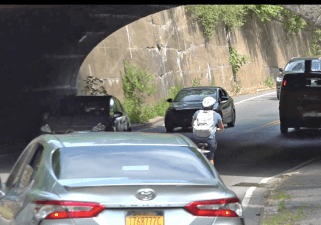Details Emerge: Beloved Owl Killed by Pick-up Truck Driver in Central Park!
'Barry' felled by maintenance vehicle that was 'traveling slowly,' Conservancy says.

Updated | Owl be damned.
“Barry,” the rock-star bird recently profiled by the New York Times, was killed by a driver of the kind of vehicle that kills too many New Yorkers — a pick-up truck!
A flack for the Central Park Conservancy told Streetsblog that the Conservancy staffer driving the maintenance vehicle was “traveling slowly (about 15 mph) using lights and flashers on the West Drive (in low 60s) doing routine park maintenance when the accidental collision occurred.”
Barred owls are rare in the park, and the circumstances around its death prompted much online speculation — especially when the Conservancy took many hours to provide any information about the incident. The not-for-profit organization earlier on Friday had released a much-analyzed and (for some) deeply troubling tweet about the bird’s demise:
It’s with a heavy heart we share that a barred owl, a beloved Central Park resident, passed away early this morning. pic.twitter.com/AYEV0gXZIr
— Central Park (@CentralParkNYC) August 6, 2021
The statement may have sounded sweet to some, but its vagueness antagonized some street-safety activists, such as the senior strategist and head writer of Transportation Alternatives, Jessie Singer, who accused the Conservancy of “victim-blaming.”
note the conservancy focuses on barry's behavior ("flying low" "searching for a meal") and not at all on what the van driver was doing, which studies show, is a very effective way to encourage victim-blaming and distract from dangerous conditions.https://t.co/iieis08vlB
— Jessie Singer (@JessieSingerNYC) August 6, 2021
The Parks Department declined to add any color to the circumstances surrounding the owl’s death. It released a general statement about automobiles in the park:
“We were sad to hear of this loss of wildlife today,” spokeswoman Crystal Howard told us. “We are committed to a car-free Central Park, only minimally allowing operationally necessary vehicles on roads and paths in order to run and care for the 840-acre green space and the amenities within.”
According to expert Robert DeCandido, who conducts birding walks in Central Park, “owls sadly do fly into moving vehicles” and can get hit by vehicles when they swoop from one side of the road to the other. He added, however, that “owls do not collide with stationary vehicles, especially at night!”
The question of motor vehicles in Central Parks is a vexed one. The city with great fanfare barred cars from Central Park in 2018, after a half-century-long campaign to wrest the preserve from motorists, who used its roads as a shortcut to get across town. Even so, many different-sized vehicles still ply the park’s streets, including maintenance vehicles, vans, mid-sized trucks and private cars owned by police officers who work at the Central Park Precinct.
The Parks Department still hasn’t redesigned the rolling roads, which remain striped and signaled for cars, causing confusion for many other users, including cyclists, pedestrians, rollerbladers, runners, horse-drawn carts and pedicabs. An e-cyclist died after crashing into a pedestrian on a park road in 2019. (The pedestrian had minor injuries.) The situation has become so chaotic and dangerous that a former city parks commissioner says he won’t bike in the greenspace anymore. Cyclist activists have been campaigning for a safe route to traverse the park, especially after a beloved East Side pediatrician was killed by a bus driver while riding on the dangerous park transverse.
Pick-up trucks, SUVs and other oversized vehicles account for a growing share of road fatalities in New York City and have contributed to the growing epidemic of traffic fatalities during the past decade.
The Parks Department contracts with the Conservancy, which was formed more than 40 years ago, to fix the down-at-the-heels greensward, for many basic functions. “Over 300 Conservancy employees tend to the Park’s complex maintenance, restoration, and architectural needs — from horticulture, tree and turf care, trash management, visitor services, and much more — resulting from massive use,” according to the Conservancy’s website. The group spends “nearly $75 million into the Park’s care each year with the sole mission of protecting and improving Central Park in perpetuity.”
This article was updated with information from the Central Park Conservancy.



